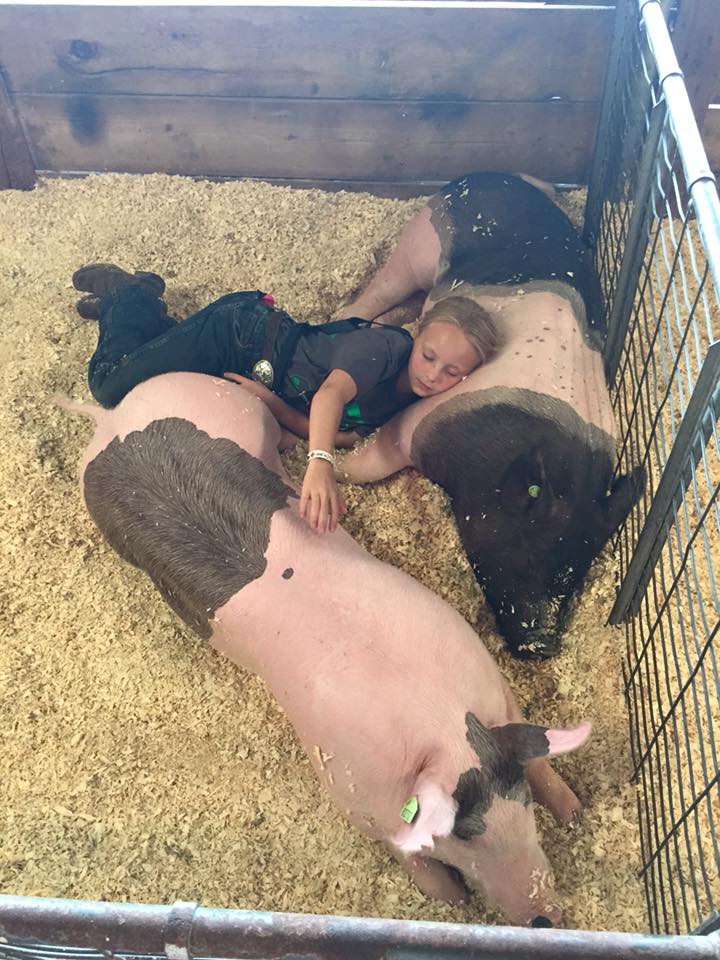A Heartwarming Bacon Day Story
 As our South Dakota State Fair wraps up, I am thinking of all the youth who showed animals this year who will soon be selling them. An article from Columbus, Indiana recently ran in the local paper. Following is an excerpt, and a nice reminder of all the hard work that our 4-H and FFA youth have put in as they prepared their animals for shows such as the recent state fair.Grace Burbrink of Columbus beamed after her 269-pound Grand Champion barrow sold for $1,900, more than 16 times the animal’s value. Although free market advocates might find it a bit confusing, the economics at the 4-H Livestock Sale make sense when the larger picture is considered.The sale is where future farmers get their introduction to the business of agriculture. Since it’s hard for many young exhibitors to let go of the animals they’ve raised for several months, many in the community strive to make their rewards lucrative.Nearly all of the 4-H youth exhibiting livestock receive twice as much as their animal is worth on the open market. For some buyers involved in agribusiness, purchases are made as a way to extend a form of reciprocity or goodwill to farm families they do business with on a regular basis.But a closer look turns up other bidders such as Hope dentist Dr. John Harker, who says he feels compelled to support the young exhibitors after watching all of his children and grandchildren go through the 4-H program.“If these kids got paid per hour for the actual time they spend with their animals, they’d make about 25 cents an hour,” Harker said.As in past years, other bidders who showed up Saturday identified themselves as former 4-H members who personally know the long hours and hard work it takes to care for livestock.They understand that when a young person puts in up to a year of sweat equity, they are receiving an invaluable lesson in responsibility, discipline and teamwork that will serve not only themselves, but their community in future years, Paetzel said.Although some bidders might mention tax breaks they will receive from a 4-H livestock purchase, others such as Harker admit those deductions really don’t amount to much at tax time.And when auctioneer Mike Mensendiek explained over the public address system that buyers only have to pay the difference between market value and sale price if they only want to make a donation and go home without anything to show for their money, that’s when it became clear.Many of the buyers were there because they have good hearts.http://www.therepublic.com/2018/07/15/generosity_pays_a_premium_livestock_auction_ends_fair_on_highbid_note/
As our South Dakota State Fair wraps up, I am thinking of all the youth who showed animals this year who will soon be selling them. An article from Columbus, Indiana recently ran in the local paper. Following is an excerpt, and a nice reminder of all the hard work that our 4-H and FFA youth have put in as they prepared their animals for shows such as the recent state fair.Grace Burbrink of Columbus beamed after her 269-pound Grand Champion barrow sold for $1,900, more than 16 times the animal’s value. Although free market advocates might find it a bit confusing, the economics at the 4-H Livestock Sale make sense when the larger picture is considered.The sale is where future farmers get their introduction to the business of agriculture. Since it’s hard for many young exhibitors to let go of the animals they’ve raised for several months, many in the community strive to make their rewards lucrative.Nearly all of the 4-H youth exhibiting livestock receive twice as much as their animal is worth on the open market. For some buyers involved in agribusiness, purchases are made as a way to extend a form of reciprocity or goodwill to farm families they do business with on a regular basis.But a closer look turns up other bidders such as Hope dentist Dr. John Harker, who says he feels compelled to support the young exhibitors after watching all of his children and grandchildren go through the 4-H program.“If these kids got paid per hour for the actual time they spend with their animals, they’d make about 25 cents an hour,” Harker said.As in past years, other bidders who showed up Saturday identified themselves as former 4-H members who personally know the long hours and hard work it takes to care for livestock.They understand that when a young person puts in up to a year of sweat equity, they are receiving an invaluable lesson in responsibility, discipline and teamwork that will serve not only themselves, but their community in future years, Paetzel said.Although some bidders might mention tax breaks they will receive from a 4-H livestock purchase, others such as Harker admit those deductions really don’t amount to much at tax time.And when auctioneer Mike Mensendiek explained over the public address system that buyers only have to pay the difference between market value and sale price if they only want to make a donation and go home without anything to show for their money, that’s when it became clear.Many of the buyers were there because they have good hearts.http://www.therepublic.com/2018/07/15/generosity_pays_a_premium_livestock_auction_ends_fair_on_highbid_note/

